It’s not a secret that runners are often Team No-Stretch. We get it. After running, all you wanna do is hop right in the shower or take a sweet nap.
But skipping a good deep stretch after your run means missing out on some very-worth-it benefits that can help you improve your running and prevent injury.
Here are some ahhh-mazing stretches to try (*ahem* make yourself do) after your next run.
11 best stretches to do after a run
After running, you should always do a series of stretches that work your legs and parts of your upper body. This can include:
- Standing quad stretch
- Standing calf stretch
- Triceps stretch
- Arms and abs stretch
- IT band stretch
- Downward Dog
- Runner’s lunge
- Hamstring stretch
- Figure four
- Butterfly stretch
- Spinal twist
Why should you stretch after running?
Taking the 5 minutes to stretch after a run might seem annoying, but it should be a priority.
When you’re pounding the pavement or hitting the trails, your core and lower body muscles (think: glutes, hamstrings, and quads) are working overtime.
If you skip the stretching, not only are you neglecting those achy muscles, you’re letting them get tighter and tighter every run. This can make running painful and less efficient and can even lead to injury.
So why should you stretch? Stretching helps improve your:
- range of motion
- overall mobility
- flexibility
According to a 2014 study, stretching may also help you be more aware of your posture and avoid slumping your shoulders forward.
Ready, set, stretch: 11 best post-running stretches
You’ve done the hard work — now it’s time to treat those muscles.
1. Standing quad stretch

This move will give your quadriceps (those front thigh muscles) a good stretch while also targeting your hip flexors for better mobility and flexibility.
- Stand with your feet hip-width apart.
- Bend right leg, bringing heel toward your booty.
- Grab right foot with right hand and pull heel as close as possible to your butt (you should feel a stretch in your quad, but it shouldn’t hurt).
- To feel a deeper stretch in your hip flexors, tilt your pelvis by tucking your hips forward.
- Pause here for 30 seconds. Make sure you’re standing straight up throughout the stretch and resist the urge to lean forward.
- Repeat on the other side.
Pro tip: If you’re having trouble balancing, try putting your free hand on your hip, or find a wall or nearby surface to hold onto.
2. Standing calf stretch
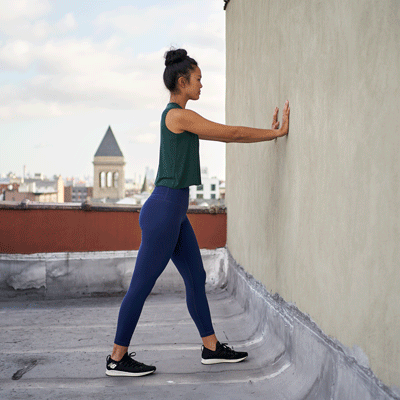
This one targets your large calf muscles and shins, which often get neglected, while also giving your ankles a good stretch.
- Stand facing a wall, a tree, or even your car. Place your hands against the surface at eye level. Stagger your left foot in front of your right at a relaxed distance.
- Keeping heels firmly planted on the floor, bend left knee and lean forward into the stretch, bending your elbows to the wall.
- Gently push into the wall until you feel your calf muscle stretch.
- Pause here for 30 seconds.
- Repeat on the other side.
Pro tip: Bend your back knee to stretch your soleus muscle (the smaller calf muscle). This is an important modification if you run long distances, which puts you more at risk of a torn soleus muscle. Stretching this muscle can also help with plantar fasciitis (inflamed tissue on the bottom of your foot that causes gnarly heel pain).
3. Triceps stretch
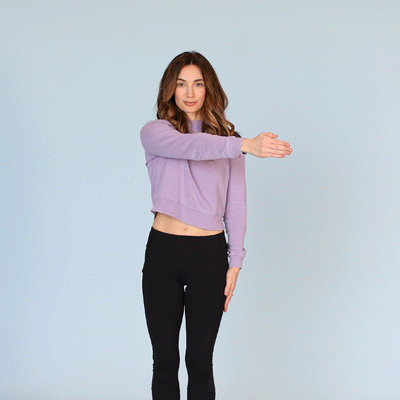
Don’t neglect your upper body just because you think running is all legs. Arm muscles like your triceps need some love, too, since you also move your arms while you run.
- Standing tall, straighten right arm across your chest toward opposite shoulder.
- Place left hand in front of right elbow and gently pull your arm closer to your shoulder.
- Pause here for 15–30 seconds.
- Repeat on the other side.
Pro tip: You can also do this triceps stretch sitting if you’re already stretching on the floor.
4. Arms and abs stretch
Running works your core, so this simple side stretch can give those deep abdominal muscles some relief. You’ll also stretch out tight shoulders and other muscles and tissues on the sides of your body.
- Stand with feet hip-width apart and cross left foot over right foot.
- Reach arms over your head and hold onto left fingertips with right hand (or grab your left wrist).
- Lower your shoulders down and away from your ears as you lean as far to the right as you can without any pain or tingles. You should feel this stretch in your sides and shoulders.
- Hold this for 15–30 seconds.
- Repeat on the other side.
5. IT band stretch
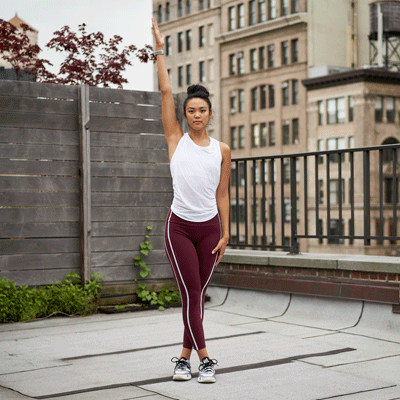
This move targets the muscles around your iliotibial (IT) band — the thick band of tissue running along the outside of your leg, from thigh to knee — to help relieve tightness. Injuries in this area are a very common for runners, so don’t neglect a tight IT band.
- Stand tall and cross your right leg in front of your left.
- Lift right hand up to the sky and keep left arm at your side.
- Bend slightly forward and reach right arm over your head toward your left side. Your left arm should lower down your leg.
- Stop when you feel a stretch on the outer part of your left leg. Pause here for 30 seconds.
- Repeat on the other side.
6. Downward Dog
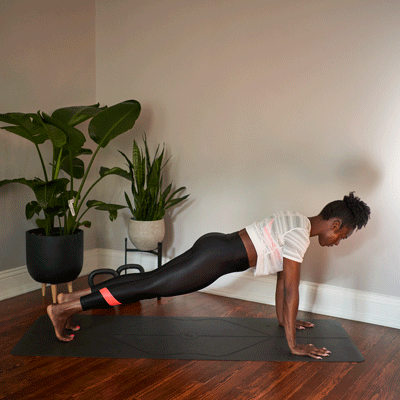
Make like a yogi and stretch your whole body. Downward Dog is awesome for your back, hammies, triceps, quads, delts, and glutes.
- Start on all fours. Make sure your hands are under your wrists and knees are under hips.
- Tuck your toes under and push into the floor with your hands as you straighten your legs and lift your booty to the sky. Hinge back at your hips as you push into your hands and lengthen spine and tailbone.
- Spread your weight evenly between both sides and make sure there’s space between your arms and ears.
- Hold this pose for up to 60 seconds.
Pro tip: Actively bend and straighten your knees to get an extra stretch in your calf muscles.
7. Runner’s lunge
This take on the classic lunge will work your calves, hip flexors, and quads.
- Stand with feet hip-width apart and a nice little bend in knees. Leaning forward at your waist, place your palms on the floor on either side of your feet.
- Bend right knee and stretch out left foot behind you, putting the ball of left foot on the floor.
- Slowly lower your hips as your flexibility level allows, letting yourself carefully fall into the stretch.
- Pause here for 30 seconds before repeating on the other side.
Pro tip: Add a pelvic tilt to feel an even deeper stretch.
8. Hamstring stretch
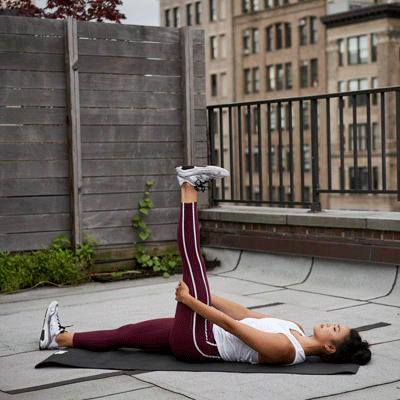
Tight hammies are a recipe for disaster. This easy hamstring stretch will help improve your performance and prevent injury.
- Lie faceup with your legs extended.
- Bend right leg slightly and place your hands behind right thigh.
- Slowly straighten right leg as you pull it toward you, flexing your heel toward the sky. (You should feel a stretch in the back of your thigh.)
- Pause here for 30 seconds.
- Repeat on the other side.
9. Figure four
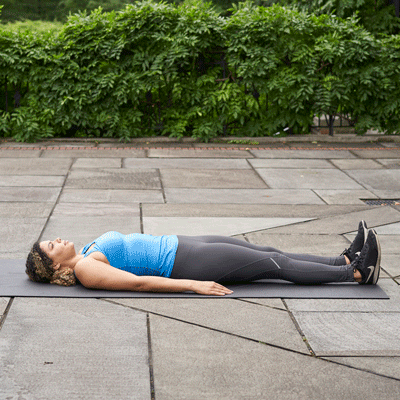
Stretch your outer hips and glutes with this fast and simple lying-down stretch. Your booty will thank you later.
- Lie faceup on the floor (grab a workout mat if you want).
- Bending your right knee, place right ankle on left thigh, just above left knee.
- Interlace your fingers behind left thigh, pulling it toward your chest. (Your legs should look like a 4.)
- Pause here for 20–60 seconds.
- Repeat on the other side.
10. Butterfly stretch
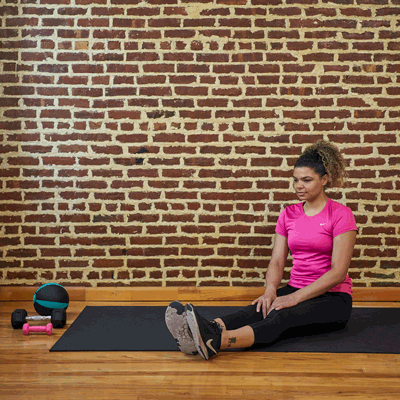
This nice little hip-opening stretch will do wonders for your gait and keep things from getting too tight on your next run.
- Take a seat on the floor, placing the bottoms of your feet together so your knees spread out to the sides (like a butterfly).
- Bring heels in as close to you as possible, maintaining a nice straight back.
- Bend forward until you notice a stretch.
Pro tip: For a deeper stretch, push your knees down using your elbows. (But don’t force them down — it shouldn’t hurt.)
11. Spinal twist
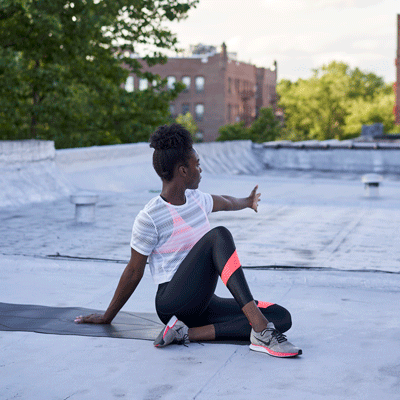
Running can do a number on your posture. This stretch helps relieve tight back muscles that keep you vertical as you run.
- Sit with your legs crossed.
- Place right hand on the floor behind right hip, with fingers pointing away from you.
- Bend right knee up to your chest, keeping your foot planted on the floor in front of you.
- Straighten left arm to your side as you face forward. Then twist your body as you place left elbow over right knee and look behind you.
- Hold for 30 seconds.
- Repeat on the other side.
Short on time? Focus on these 5 stretches
If you basically have no minutes to stretch it out post-run, make these a priority:
- Standing quad stretch
- Runner’s lunge
- Butterfly stretch
- Downward Dog
- IT band stretch
Stretching after running 101
You don’t have to be king or queen of yoga to get these stretches down. Here are some fast tips to get started:
- How long should you stretch it out? Research points to stretching each muscle for 15–30 seconds. Tally that all up and it means your stretch sesh is about 7 minutes total — easy-peasy. (If you have an extra-tight muscle, you can stretch that one a little longer, say about 60 seconds.)
- How far do you stretch? Your stretches should be deep enough so you feel some tension, but not so intense that you’re feeling any sharp pains or tingles. If you feel those, take it easy.
- Should you stretch cooled down or warmed up? Research suggests it’s a good idea to stay warm. This makes it easier for you to move and reduces the chance of injury.
- Think it, track it. Thinking of your stretches as a part of your whole running routine can help you feel and see the benefits. Also, try jotting down how you feel after your run and stretches are over to track your progress over time.
- Remember to breathe. This not only feels good but also helps you get into a deeper stretch.
The takeaway
Stretching after running is just as important as the run itself. A good post-run stretch can relax your achy muscles and help improve your range of motion, flexibility, and overall mobility. So, get into it!
Psst: Up your stretch game and start planning that 10K. You can run your race however you want — virtually or IRL, solo or with some pals. There’s a plan for any level, too, including total newbs and well-seasoned runners, so no excuses are necessary.


0 Commentaires